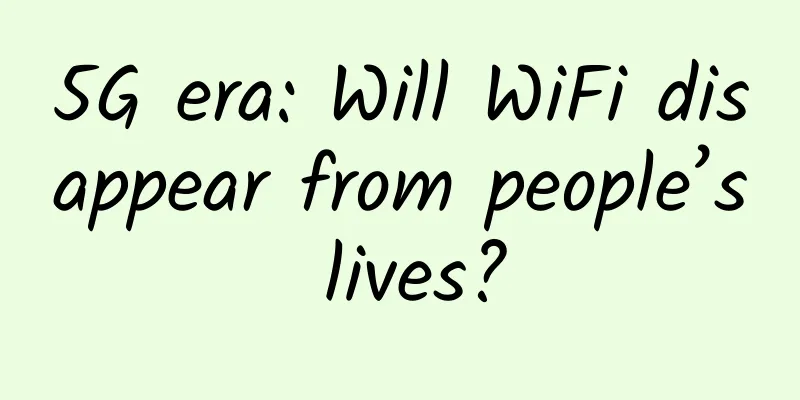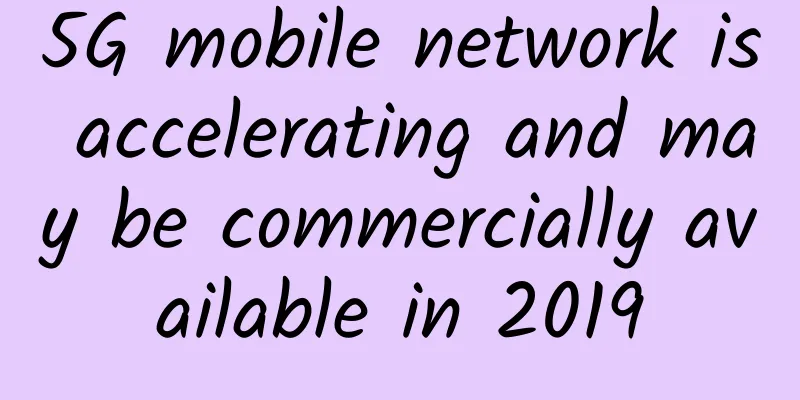5G era: Will WiFi disappear from people’s lives?

|
WiFi has gradually penetrated into our daily lives. Whether it is a mobile phone, tablet, or smart TV, almost all connected devices have the WiFi logo. However, Bloomberg believes that WiFi will gradually disappear from people's lives. According to Leifeng.com, major mobile operators in the United States have begun to provide unlimited data packages. Consumers will no longer need to switch back and forth between cellular networks and WiFi to avoid high data charges. This key change may cause WiFi to exit the stage of history. With the emergence of competitive new technologies, the future of WiFi may be even bleaker. “You may notice a big shift where your regular coffee shop may not be as eager to provide Wi-Fi to customers,” said Tim Farrar, founder of Telecom Media Finance Associates Inc.
Farrar predicts that in a world of unlimited data, consumers will use Wi-Fi in public places such as stadiums and airports for one-third of their data traffic, down from half now. Barry Golbert, a researcher at Strategy Analytics, believes this means that companies will upgrade public Wi-Fi less frequently, and smartphone users may even stop turning on Wi-Fi. "Unlimited data plans have become the norm at Sprint, and consumers are no longer willing to wait to connect to a WiFi hotspot to watch the latest video, so they're always using cellular networks," said Craig Moffett, an analyst at MoffettMoffettNathanson LLC. "Consumers are rational: When pricing favors WiFi, they use it more; and when price incentives shift, their behavior changes." The change isn't just happening in public places: Almost a third of people don't use broadband to connect to the internet at home because they have unlimited data plans on their phones, according to a survey released Thursday by ReportLinker. However, the decline of WiFi's influence may be slow and irregular. Although unlimited data plans make WiFi unnecessary for mobile phones, many home devices, such as PCs or Amazon's Echo, still need WiFi to connect to the Internet. And WiFi can also serve as a supplement to cover office buildings and homes where mobile phone signals are poor. In addition, some mobile operators also need to rely on WiFi networks to handle a large part of the growing traffic demand. Streaming services like Netflix and Spotify will cause network congestion if they rely entirely on cellular networks. “Wi-Fi continues to lead in performance and the ability to carry large amounts of data,” said Kevin Robinson, vice president of marketing for the Wi-Fi Alliance. “The market will determine which technology provides the best service to end users, and the idea of replacing Wi-Fi may be overly optimistic.” Of course, unlimited data plans aren't the only threat to Wi-Fi. Wi-Fi has been around for 20 years and has spawned a nearly $20 billion market for Wi-Fi service providers and chip makers, largely because its technology is open and uses unlicensed spectrum to provide services. But now, Wi-Fi faces competition from other technologies that operate in the same frequency bands. LTE-U A new system called LTE-U (LTE in Unlicensed Spectrum), which uses unlicensed spectrum to provide network services, will make the spectrum that WiFi relies on more crowded. In the past few decades, those unlicensed spectrums were used primarily for garage door openers, cordless phones, and baby monitors. Today, those spectrums are largely occupied by WiFi networks that connect smartphones, laptops, set-top boxes, game consoles, and a whole host of smart devices. With the entry of LTE-U, WiFi is likely to be replaced. Kyung Mun, a researcher at Mobile Experts, said, "In the future, operators will use LTE-U to cover areas where WiFi has been used traditionally." Developed by wireless carriers and their suppliers, LTE-U could hamper companies trying to use Wi-Fi to provide calling services, such as Comcast, and those experimenting with fiber-optic networks, such as Alphabet, the parent company of Google. But LTE-U has benefits, too. Users no longer have to enter passwords and log into public WiFi hotspots. They can switch seamlessly between their carrier’s cellular network and LTE-U without even noticing the difference. Amit Jain, vice president of marketing and product management at hardware maker SpiderCloud Wireless, said LTE-U and LTE-LAA require less access equipment, with a building of 180,000 square feet (about 16,700 square meters) requiring only 24 new access points. If WiFi is used, 80 access points are needed. However, the deployment costs of the two are similar. Mobile Experts predicts that by 2020, annual shipments of LTE-U/LTE-LAA access devices will increase from tens of thousands in 2016 to 1.1 million units. "LTE will be in homes, in businesses, and WiFi will become a legacy technology," said Chetan Sharma, an independent analyst. Even large WiFi access equipment manufacturers such as Cisco are considering developing new equipment compatible with WiFi and LTE-U technologies. Mike Iandolo, vice president and general manager of Cisco's Mobility Technology Group, said, "It is too early to say who will win. LTE has its advantages, but WiFi still has room to exist." CBRS Another technology that could make WiFi obsolete is called CBRS, which stands for Citizens Broadband Radio Service. CBRS allows anyone to share a large amount of spectrum currently used by the U.S. Navy. In February, Nokia, Alphabet and Qualcomm used this spectrum to test LTE technology and broadcast a high-definition video live broadcast of a car rally in Las Vegas. MIchael Peeters, head of Nokia's innovation portfolio management and chairman of the CBRS Alliance, believes that CBRS is more reliable than WiFi and may eventually become a better choice for factories, airports and ports. He said the first batch of commercial CBRS equipment will be certified in mid-2017. 5G In addition to LTE-U and CBRS, the biggest threat to WiFi is the upcoming large-scale commercialization of 5G. 5G technology allows users to download high-definition videos in one second. Through CBRS, mobile operators can use shared spectrum to deploy 5G technology faster and easier, rather than obtaining spectrum authorization through auctions or transactions. Even in the near term, WiFi has begun to disappear from people's daily lives. "Before I had to look for Wi-Fi hotspots everywhere, which was very inconvenient for me," said Michael Kimbrough, a Verizon Wireless customer who signed up for an unlimited data plan last month. "Now I don't have to do that anymore." |
>>: Correctly understand the wrong ideas in RS-485 wiring process
Recommend
Tencent Cloud Spring Purchase: 2C2G4M cloud server only 40 yuan/year or 200 yuan/3 years, 4C8G10M cloud server only 211 yuan/year
Tencent Cloud launched a Spring Festival shopping...
Can you distinguish between distribution, high concurrency and multithreading?
When these three words are mentioned, do many peo...
OlinkCloud: 20% off all VPS starting at $4/month, 40% off dedicated servers, pure AS9929 lines in Germany/San Jose, USA
Olink.Cloud is a site under DiaHosting, mainly pr...
Digital Experience Monitoring and Network Observability
It’s clear that in the business world, digital op...
HostYun Hong Kong Tsuen Wan AMD series VPS simple test
The day before yesterday, we shared the informati...
How does DNS work? See how this "translator" converts domain names and IP addresses
[[277197]] 1. What is DNS? DNS (Domain Name Syste...
Double 11 Carnival, drink this bowl of "traffic control" soup
[[350322]] As the Double 11 shopping festival app...
HXServers: $3/month KVM-dual-core CPU, 1GB memory, 60G NVMe, 2Gbps unlimited traffic, Los Angeles/Phoenix data center
HXServers is a new foreign hosting company that o...
Top 10 economic predictions for the tech industry in 2024
As we stand on the cusp of a new year, the tech i...
Computer software: Recommend 10 practical office efficiency tools
[[395494]] 1. Everything search tool Everything i...
Huawei launches MAE-Litem, the world's first integrated converged website for wireless, transmission, and core networks, making digital transformation in the industry a breeze
Recently, the 16th International Coal Expo was he...
TmhHost Hong Kong CN2 high-defense server online and simple test
TmhHost recently launched the Hong Kong CN2 high-...
Interpretation of China's first LTE IoT multi-mode field test: Industry chain collaboration resolves the long-tail fragmentation problem
Recently, Qualcomm has cooperated with China Mobi...
The cutting-edge of Internet technology - a comprehensive analysis of TSN
[[271597]] TSN is the abbreviation of time-sensit...









